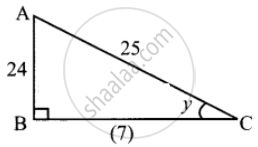Advertisements
Advertisements
प्रश्न
Find cos(x − y), given that cos x = `- 4/5` with `pi < x < (3pi)/2` and sin y = `- 24/25` with `pi < y < (3pi)/2`
उत्तर
cos x = `- 4/5`
`pi < x < (3pi)/2`
⇒ x is in III quadrant
From ΔPQR,
PQ = `sqrt(5^2 - 4^2)`
= `sqrt(25 - 16)`
= `sqrt(9)`
= 3
Since x is in III quadrant
Both sin x and cos x are negative
∴ sin x = `- 3/5` and cos x = `- 4/5`
sin y = `- 24/25` and y is in III quadrant
Both sin y and cos y are negative
From ΔABC,
BC = `sqrt(25^2 - 24^2)`
= `sqrt(625 - 576)`
= `sqrt(49)`
= 7
So, sin y = `- 24/25` = cos x cos y + sin x si y
= `(- 4/5)(- 7/25) + (-3/5)(- 24/25)`
= `28/125 + 72/125`
= `100/125`
= `4/5`
APPEARS IN
संबंधित प्रश्न
Find the values of sin(480°)
Find the values of sin (– 1110°)
Show that `sin^2 pi/18 + sin^2 pi/9 + sin^2 (7pi)/18 + sin^2 (4pi)/9` = 2
If sin A = `3/5` and cos B = `9/41, 0 < "A" < pi/2, 0 < "B" < pi/2`, find the value of cos(A – B)
Prove that sin(π + θ) = − sin θ.
Prove that sin(30° + θ) + cos(60° + θ) = cos θ
Prove that cos(A + B) cos(A – B) = cos2A – sin2B = cos2B – sin2A
Show that tan(45° − A) = `(1 - tan "A")/(1 + tan "A")`
If tan x = `"n"/("n" + 1)` and tan y = `1/(2"n" + 1)`, find tan(x + y)
If θ + Φ = α and tan θ = k tan Φ, then prove that sin(θ – Φ) = `("k" - 1)/("k" + 1)` sin α
Prove that sin 4α = `4 tan alpha (1 - tan^2alpha)/(1 + tan^2 alpha)^2`
Express the following as a sum or difference
sin 35° cos 28°
Express the following as a sum or difference
sin 5θ sin 4θ
Show that `cos pi/15 cos (2pi)/15 cos (3pi)/15 cos (4pi)/15 cos (5pi)/15 cos (6pi)/15 cos (7pi)/15 = 1/128`
Show that `((cos theta -cos 3theta)(sin 8theta + sin 2theta))/((sin 5theta - sin theta) (cos 4theta - cos 6theta))` = 1
If A + B + C = 180°, prove that sin2A + sin2B + sin2C = 2 + 2 cos A cos B cos C
If ∆ABC is a right triangle and if ∠A = `pi/2` then prove that sin2 B + sin2 C = 1
Choose the correct alternative:
If `pi < 2theta < (3pi)/2`, then `sqrt(2 + sqrt(2 + 2cos4theta)` equals to
Choose the correct alternative:
Let fk(x) = `1/"k" [sin^"k" x + cos^"k" x]` where x ∈ R and k ≥ 1. Then f4(x) − f6(x) =
